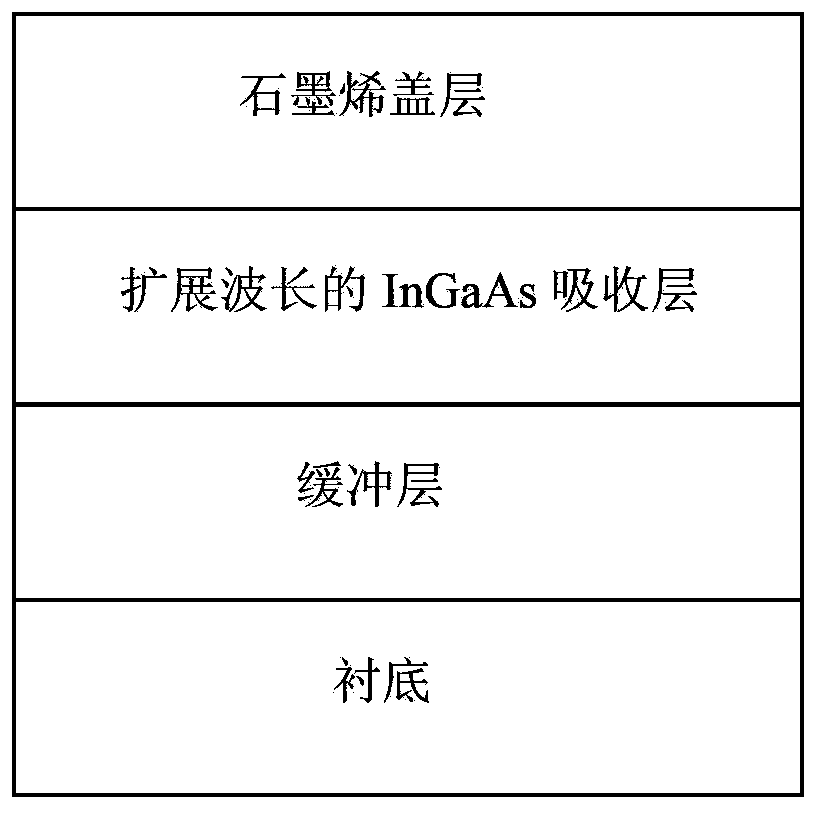Graphene enhancement type InGaAs infrared detector
An infrared detector and graphene technology, applied in semiconductor devices, electrical components, circuits, etc., can solve problems such as difficulty in further improving mobility, affecting efficient absorption and conversion, and difficulty in growing InP single crystals, so as to improve photoelectric conversion efficiency , the effect of low defect density and high relaxivity
- Summary
- Abstract
- Description
- Claims
- Application Information
AI Technical Summary
Problems solved by technology
Method used
Image
Examples
specific Embodiment approach 1
[0024] The structure of a graphene-enhanced InGaAs infrared detector with a cut-off wavelength of 2.6 μm is: sequentially grown on an n-type GaAs substrate with a thickness of about 1 μm and a Si doping concentration of 2×10 18 cm -3 n-type InAs 0.60 P 0.40 The buffer layer continues to grow to a thickness of 2.5 μm and a Si doping concentration of 8×10 16 cm -3 (lowly doped) n-type In 0.82 Ga 0.18 As absorption layer, and finally a single-layer p-type graphene cap layer is grown to form a pin detector structure.
[0025] In this embodiment mode, the S-doped n-type GaAs is used as the substrate, and the Si-doped InAs is grown on the GaAs substrate by a two-step MOCVD system. 0.60 P 0.40 Buffer layer, first grow a layer of InAs of about 100nm at a temperature of 450℃ 0.60 P 0.40 , and then raise the temperature to 580 °C, during which the buffer layer InAs 0.60 P 0.40 Annealing and recrystallization releases the stress caused by the lattice mismatch and becomes the i...
specific Embodiment approach 2
[0026] The structure of a graphene-enhanced InGaAs infrared detector with a cut-off wavelength of 2.6 μm is: sequentially grown on an n-type InP substrate with a thickness of about 2 μm and a Si doping concentration of 2×10 18 cm -3 n-type In 0.82 Al 0.18 As buffer layer, continue to grow to a thickness of 3.5 μm and a Si doping concentration of 8×10 16 cm -3 (lowly doped) n-type In 0.82 Ga 0.18 As absorption layer, and finally a multilayer p-type graphene capping layer is grown to form a pin detector structure.
[0027]In this embodiment mode, the S-doped n-type InP is used as the substrate, and the Si-doped In is grown on the InP substrate by a MOCVD system using a two-step method. 0.82 Al 0.18 As buffer layer, first grow a layer of In about 200nm at a temperature of 450°C 0.82 Al 0.18 As, and then the temperature was raised to 580 °C, during which the buffer layer In 0.82 Al 0.18 As annealing and recrystallization releases the stress caused by the lattice mismatc...
PUM
 Login to View More
Login to View More Abstract
Description
Claims
Application Information
 Login to View More
Login to View More - R&D
- Intellectual Property
- Life Sciences
- Materials
- Tech Scout
- Unparalleled Data Quality
- Higher Quality Content
- 60% Fewer Hallucinations
Browse by: Latest US Patents, China's latest patents, Technical Efficacy Thesaurus, Application Domain, Technology Topic, Popular Technical Reports.
© 2025 PatSnap. All rights reserved.Legal|Privacy policy|Modern Slavery Act Transparency Statement|Sitemap|About US| Contact US: help@patsnap.com

